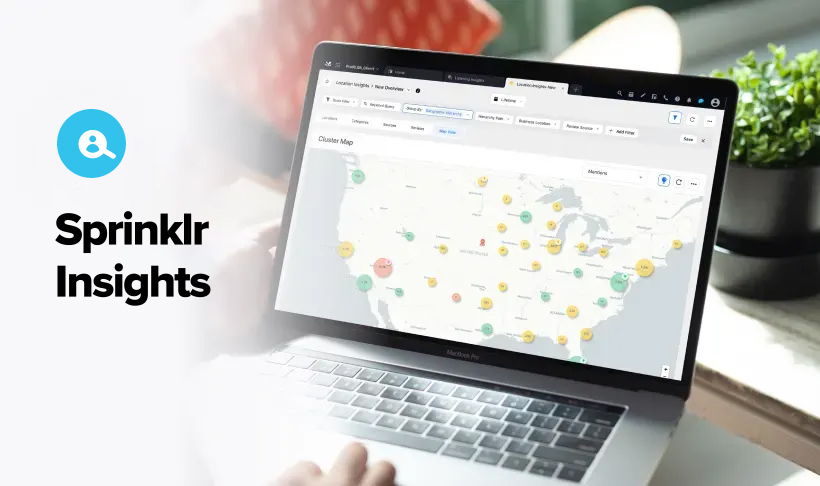- What are PR Campaigns?
- Importance of PR campaigns
- Why should brands care about public relations?
- When do brands typically use PR campaigns
- What channels to use for PR campaigns
- PR measurement - KPIs for your PR campaigns
- Tips for a successful PR campaign
- Why is Sprinklr the best PR measurement tool for your brand?
What are PR Campaigns?
A PR campaign is not just a series of activities designed to drive awareness or trust around a brand, a product, an event, an executive, or a business partner. A good PR campaign should ultimately drive a business outcome like increasing revenue. So PR campaigns are typically designed to cover specific business goals such as pushing website traffic, getting noticed about a new product, or drawing attention to a cause.
Importance of PR campaigns
It happens constantly: you see competitors in your field getting noticed by the press or brands, acquiring shares and likes on social media. You might not realize that their activities aren't any more special than what you do. The biggest difference is those companies and brands know how to leverage public relations.
You release an industry-leading press release, run an innovative campaign, or go viral on social media — and BAM! Suddenly, people brush off your competitors because they're too occupied looking at you. It steals the limelight away from your competitors.
PR has regained its prowess with the pandemic putting many unknowns into the equation. Here's how — people spend more time on social media, and marketing budgets are being cut. Brands now understand that they needed to build something beyond their products and offerings, which was a strong connection through their PR campaigns.
Why should brands care about public relations?
There might be alternative ways to shape your audience's perceptions. But companies invest in PR because it gives them a say in those perceptions.
Maintaining a solid Public Relations strategy can aid you in finding opportunities to build and grow your brand. It allows you to create relationships with media outlets, influencers, and other key people who can advocate for your company.
Additionally, constancy in your public relations campaigns can assist in reducing the time, cost, and effort of your marketing team while maintaining sales and revenue.
PR campaigns also allow you to establish an emotional bond with your target audience. Emotional bonds can be effective in terms of building brand loyalty. As we discover all the time, people buy from brands they like, even if those brands cost a million bucks!
However we define PR, it's essential to think of the end goal of your PR activities. With intention leading the way, you can mold your audience's opinions for your desired outcomes.
When do brands typically use PR campaigns
The immediate short-term goal of a Public Relations campaign can be multifold - from building a media narrative to controlling the spread of negative brand information. It can also be used as a tactic to generate awareness about a particular event, project, deal, or investment. Some of the top situations for PR campaigns are:
Crisis management
Brands sometimes have to do damage control to avoid losing customer trust. PR activities and communications can place you back in the public eye for the right reasons.
Brand management
Startups or brands that want to grow their clientele can use PR to reach a wider audience. It helps the public understand your company beyond your marketing messages and products.
Internal relations
PR strategies can also serve internal stakeholders (employees, shareholders, etc.). It is vital for companies with multiple locations or remote employees.
What channels to use for PR campaigns
Public relation is a content-heavy job — specifically written communications like press releases. In whichever way you build your PR strategy, your content usually falls into one of the three types:
Earned media
Earned Media is the tidemark of public relations because it's essentially complimentary publicity. Instead of pitching reporters and news outlets, your audience glorifies you on your behalf. Word-of-mouth marketing is influential because consumers trust other consumers more than brands.
That said, earned media is also the most challenging to come by. For example, you can encourage your customers to leave reviews and share on social media. But eventually, it's up to them how and when they choose to publicize you.
Paid media
Paid media is one of the most accessible types of media for PR agencies and professionals to control. Once you form a press release or other content, you can advertise it just as your other marketing. Channels might include Newswires, PPC ads, social media ads, or influencer marketing.
Naturally, paid media can also be the most pricey. In addition to the costs of content creation, you're also paying to publish it. Also, generally, Paid Media evokes lower trust than earned mentions.
Owned media
Owned media is all the content that your company holds. Case studies, blog posts, social media copy, website copy, original images, email newsletters, etc., are all examples of owned media.
Owned media serves as the basis of your PR campaigns. You can govern when, how, and where it's published, make changes to the content, and chase its performance.
PR measurement - KPIs for your PR campaigns
At a strategic level, marketing and advertising campaigns are focused on driving sales; on the contrary, Public Relations teams usually have different campaign KPIs that aim to measure the following:
The volume of media attention attracted
Awareness generated
Brand reputation/Trust Improvement
Building stakeholder relations
An effective KPI is backed by an actionable metric that keeps your strategy on track. But what constitutes a "good PR campaign metric"?
We've identified top KPIs you'll want to consider tracking for your campaigns. Always begin with the items that drive the most significant business impact. Because let's face it: there's a lot you can hunt. But if you hunt everything under the sun, you'll spend all your time accumulating numbers rather than putting those numbers to work!
The volume of campaign coverage
Active coverage or the number of times your campaign got mentioned by popular media outlets and influences across channels. You should also create a subset of this KPI specifically focused on top-tier publications for your industry and audience. PR professionals often create a list of anywhere from 10 to 50 top publications and then strive to make them talk about their campaign.
Share of voice or the percentage of coverage for your brand compared to competitors and is the favorite KPI among competitive, growth-minded CEOs. You must prove that your campaign drastically improved your Share of Voice during the campaign and during the pre and post-campaign stages.
It’s important to note that share-of-voice can be tracked by volume or reach. For instance, your competitor may have a higher volume of mentions, but you might be in higher-reach publications.
Quality of campaign coverage
Prominence or the placement of your brand and campaign keywords within the content posted by publications and influencers. The coverage is considered high-quality if the campaign is mentioned in prominent positions, such as the title of an article, as the readers are more likely to remember your brand and campaign.
Key message penetration measures whether the fundamental messaging of the campaign was projected in the way you wished. The campaign's key message could be centered around the brand's value proposition, vision, and preferred associations, such as sustainable or customer-centric. A car brand’s sustainability PR campaign might want to be mentioned around efficient mileage.
Sentiment or the tone of the articles around your campaign. This metric lets you see if your campaign is creating the positive associations you hope for or if it is causing any negative backlash.
Outreach of campaign content
Earned Engagement or the number of likes, shares, comments, etc. that your campaign generates? This metric should capture engagements across sources, including how news articles are being shared on social media. This provides a better measure of how many people actually read about the campaign and whether it resonated with them.
Potential reach or the potential audience reached with your campaign. This classic PR metric can help you measure whether your campaign reached influencers and journalists.
Geographical presence helps to assess your success by checking if the campaigns had a global footprint covering your targeted demographics.
Business outcomes of campaign coverage
Earned traffic or the number of visitors that were driven to your website due to your earned coverage and link placement. It is helpful to look at the numbers in the different stages of your campaign period.
Domain authority can help check if the campaign resulted in higher visibility for the brand on the web.Many top-tier media outlets have high-ranking sites, so earning a media placement in them can have a big impact on your SEO. High domain authority means your customers are likely to find you online!
Event promotion metrics for offline PR events where we measure the above metrics for the media coverage and offline metrics such as event attendance, building relationships with speakers and attendees, etc.
Campaign KPIs are only effective if they help your teams understand and evaluate how their actions contribute to overall organizational goals. Organizations don’t need to choose too many KPIs to be successful. Still, the quality of each KPI is key — determining which metrics are most important to the organization, which are also dynamic and measurable.
Tips for a successful PR campaign
Successful PR campaigns hinge on a solid communication strategy with three steps:
Focusing on the brand's goals and vision
Creating the right message for the intended audience
Choosing the proper channels or formats (Paid/Earned/Owned) for messaging
Look at some of the outstanding campaigns — be it LEGO's "Empowering through play," Coinbase's "Super Bowl QR Code" campaign, or Airbnb's "For Ukraine" campaign - and you will be amazed at how PR helped to build trust, strengthen relationships, keep the brands relevant, and also support purpose-driven future.
LEGO's campaign is my personal favorite. They have always believed in the power of play as a vehicle for children's learning and believe that playful experiences can develop the skills required to serve them and their communities. To showcase their commitment to play, the LEGO Foundation donated 600 LEGO Magnetic Resonance Imaging (MRI) Scanners to hospitals worldwide to help children cope with the fear of MRI scans.
The game sets help children to understand the process of having an MRI scan and, through role-playing and dialogue, build strength, courage, and resilience. This not only built good faith around the brand and boosted its sales. PR helps to drum up interest and put you in the limelight. As more and more people start talking about you, more are the chances of people buying your product and services.
Why is Sprinklr the best PR measurement tool for your brand?
Measuring PR KPIs traditionally can involve a lot of manual effort. But with the right PR tool, you can conquer the PR campaign measurement strategy. PR measurement and reporting tools will help track your brand-specific PR campaign metrics. Using a PR tool that gives you an in-depth analysis allows you not just to quantify the impact of your campaign but helps you prove your return on investment (ROI) and justify the success of your campaigns.
Combined with PR capabilities such as media monitoring, social listening, audience insights, and Journalist/Publication discovery into a single platform, a PR tool enables you to:
Track media coverage around your brand or campaign and measure the impact or business value created
Calculate the share of mind your brand generates on media vs. your competitors
Stay on top of viral media content around your brand, executives, partners, and other stakeholders that can impact your reputation
Identify journalists and publications to partner with to control the brand narrative and strengthen the brand perception
Craft your communication strategy and drive thought leadership by discovering industry content that resonates with the audience
And much more
Frequently Asked Questions
A PR campaign is not just a series of activities designed to drive awareness or trust around a brand, a product, an event, an executive, or a business partner. PR campaigns are typically designed to cover specific business goals, such as pushing website traffic, getting noticed about a new product, or drawing attention to a cause.
Thank you for contacting us.
A Sprinklr representative will be in touch with you shortly.
Contact us today, and we'll create a customized proposal that addresses your unique business needs.
Request a Demo
Welcome Back,
No need to fill out any forms — you're all set.






